Extreme Multi Label Classification
Extreme multi-label classification is the task of assigning multiple labels to a single instance from an extremely large label space.
Papers and Code
GraphEx: A Graph-based Extraction Method for Advertiser Keyphrase Recommendation
Sep 05, 2024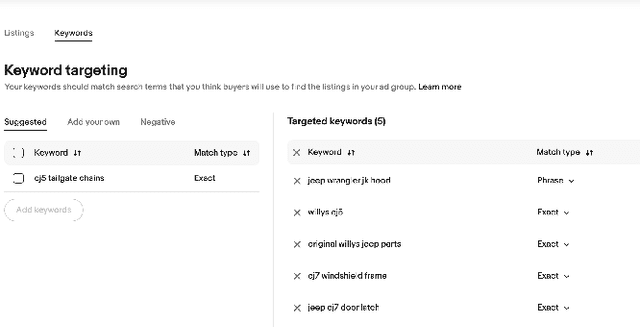

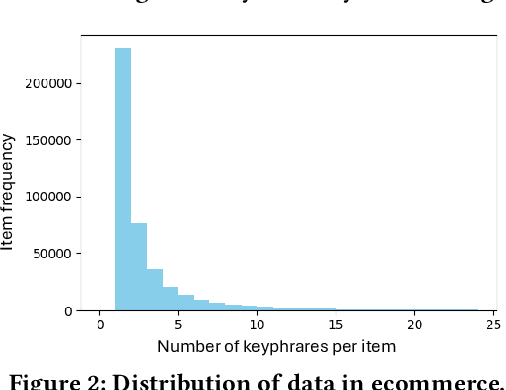

Online sellers and advertisers are recommended keyphrases for their listed products, which they bid on to enhance their sales. One popular paradigm that generates such recommendations is Extreme Multi-Label Classification (XMC), which involves tagging/mapping keyphrases to items. We outline the limitations of using traditional item-query based tagging or mapping techniques for keyphrase recommendations on E-Commerce platforms. We introduce GraphEx, an innovative graph-based approach that recommends keyphrases to sellers using extraction of token permutations from item titles. Additionally, we demonstrate that relying on traditional metrics such as precision/recall can be misleading in practical applications, thereby necessitating a combination of metrics to evaluate performance in real-world scenarios. These metrics are designed to assess the relevance of keyphrases to items and the potential for buyer outreach. GraphEx outperforms production models at eBay, achieving the objectives mentioned above. It supports near real-time inferencing in resource-constrained production environments and scales effectively for billions of items.
From Lazy to Prolific: Tackling Missing Labels in Open Vocabulary Extreme Classification by Positive-Unlabeled Sequence Learning
Aug 22, 2024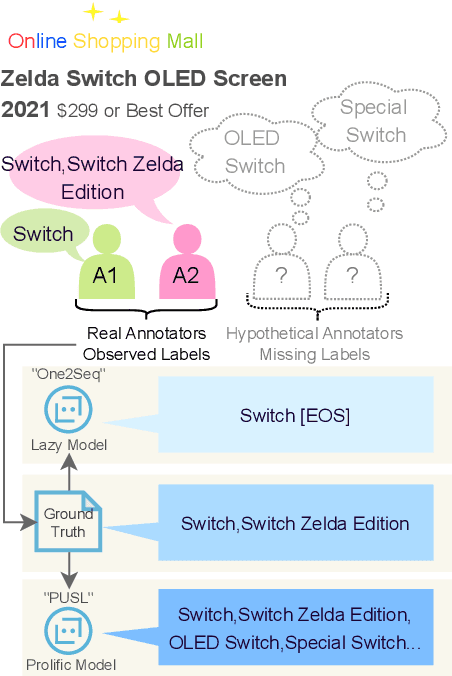
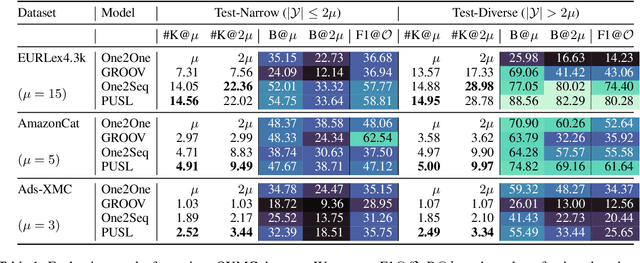
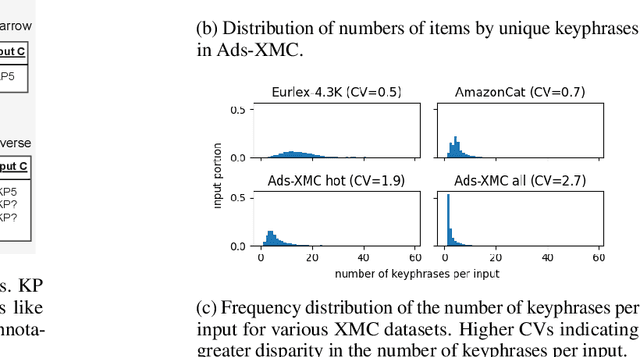

Open-vocabulary Extreme Multi-label Classification (OXMC) extends traditional XMC by allowing prediction beyond an extremely large, predefined label set (typically $10^3$ to $10^{12}$ labels), addressing the dynamic nature of real-world labeling tasks. However, self-selection bias in data annotation leads to significant missing labels in both training and test data, particularly for less popular inputs. This creates two critical challenges: generation models learn to be "lazy'" by under-generating labels, and evaluation becomes unreliable due to insufficient annotation in the test set. In this work, we introduce Positive-Unlabeled Sequence Learning (PUSL), which reframes OXMC as an infinite keyphrase generation task, addressing the generation model's laziness. Additionally, we propose to adopt a suite of evaluation metrics, F1@$\mathcal{O}$ and newly proposed B@$k$, to reliably assess OXMC models with incomplete ground truths. In a highly imbalanced e-commerce dataset with substantial missing labels, PUSL generates 30% more unique labels, and 72% of its predictions align with actual user queries. On the less skewed EURLex-4.3k dataset, PUSL demonstrates superior F1 scores, especially as label counts increase from 15 to 30. Our approach effectively tackles both the modeling and evaluation challenges in OXMC with missing labels.
Can Graph Neural Networks Learn Language with Extremely Weak Text Supervision?
Dec 11, 2024



While great success has been achieved in building vision models with Contrastive Language-Image Pre-training (CLIP) over Internet-scale image-text pairs, building transferable Graph Neural Networks (GNNs) with CLIP pipeline is challenging because of three fundamental issues: the scarcity of labeled data and text supervision, different levels of downstream tasks, and the conceptual gaps between domains. In this work, to address these issues, we leverage multi-modal prompt learning to effectively adapt pre-trained GNN to downstream tasks and data, given only a few semantically labeled samples, each with extremely weak text supervision. Our new paradigm embeds the graphs directly in the same space as the Large Language Models (LLMs) by learning both graph prompts and text prompts simultaneously. To accomplish this, we improve state-of-the-art graph prompt method, and then propose the first graph-language multi-modal prompt learning approach for exploiting the knowledge in pre-trained models. Notably, due to the insufficient supervision for fine-tuning, in our paradigm, the pre-trained GNN and the LLM are kept frozen, so the learnable parameters are much fewer than fine-tuning any pre-trained model. Through extensive experiments on real-world datasets, we demonstrate the superior performance of our paradigm in few-shot, multi-task-level, and cross-domain settings. Moreover, we build the first CLIP-style zero-shot classification prototype that can generalize GNNs to unseen classes with extremely weak text supervision.
Open-world Multi-label Text Classification with Extremely Weak Supervision
Jul 08, 2024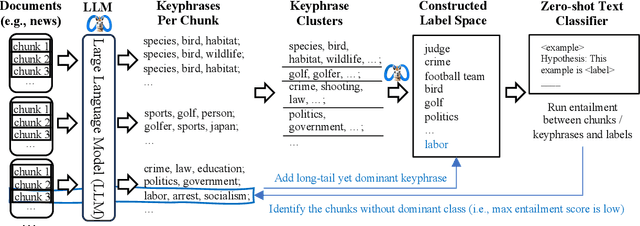
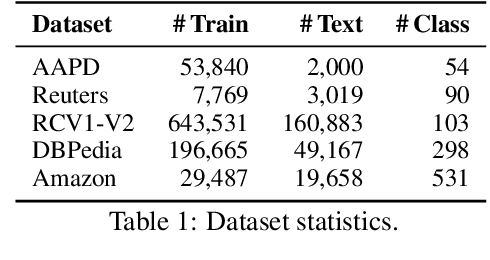
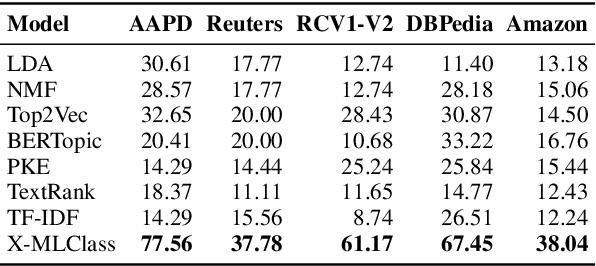
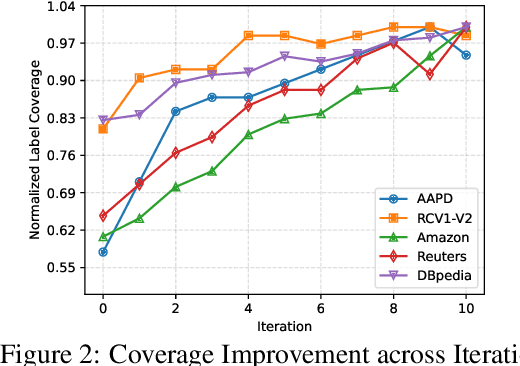
We study open-world multi-label text classification under extremely weak supervision (XWS), where the user only provides a brief description for classification objectives without any labels or ground-truth label space. Similar single-label XWS settings have been explored recently, however, these methods cannot be easily adapted for multi-label. We observe that (1) most documents have a dominant class covering the majority of content and (2) long-tail labels would appear in some documents as a dominant class. Therefore, we first utilize the user description to prompt a large language model (LLM) for dominant keyphrases of a subset of raw documents, and then construct a (initial) label space via clustering. We further apply a zero-shot multi-label classifier to locate the documents with small top predicted scores, so we can revisit their dominant keyphrases for more long-tail labels. We iterate this process to discover a comprehensive label space and construct a multi-label classifier as a novel method, X-MLClass. X-MLClass exhibits a remarkable increase in ground-truth label space coverage on various datasets, for example, a 40% improvement on the AAPD dataset over topic modeling and keyword extraction methods. Moreover, X-MLClass achieves the best end-to-end multi-label classification accuracy.
LOTUS: Enabling Semantic Queries with LLMs Over Tables of Unstructured and Structured Data
Jul 16, 2024



The semantic capabilities of language models (LMs) have the potential to enable rich analytics and reasoning over vast knowledge corpora. Unfortunately, existing systems lack high-level abstractions to perform semantic queries at scale. We introduce semantic operators, a declarative programming interface that extends the relational model with composable AI-based operations for semantic queries over datasets (e.g., sorting or aggregating records using natural language criteria). Each operator can be implemented and optimized in multiple ways, opening a rich space for execution plans similar to relational operators. We implement our operators and several optimizations for them in LOTUS, an open-source query engine with a Pandas-like API. We demonstrate LOTUS' effectiveness across a series of real applications, including fact-checking, extreme multi-label classification, and search. We find that LOTUS' programming model is highly expressive, capturing state-of-the-art query pipelines with low development overhead. Specifically, on the FEVER dataset, LOTUS' programs can reproduce FacTool, a recent state-of-the-art fact-checking pipeline, in few lines of code, and implement a new pipeline that improves accuracy by $9.5\%$, while offering $7-34\times$ lower execution time. In the extreme multi-label classification task on the BioDEX dataset, LOTUS reproduces state-of-the art result quality with its join operator, while providing an efficient algorithm that runs $800\times$ faster than a naive join. In the search and ranking application, LOTUS allows a simple composition of operators to achieve $5.9 - 49.4\%$ higher nDCG@10 than the vanilla retriever and re-ranker, while also providing query efficiency, with $1.67 - 10\times$ lower execution time than LM-based ranking methods used by prior works. LOTUS is publicly available at https://github.com/stanford-futuredata/lotus.
UniDEC : Unified Dual Encoder and Classifier Training for Extreme Multi-Label Classification
May 04, 2024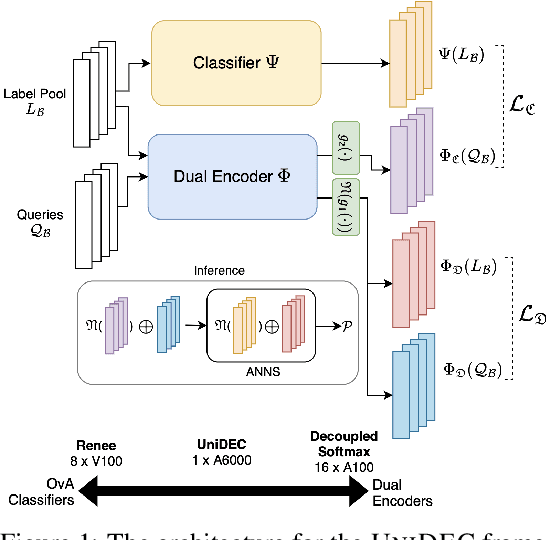
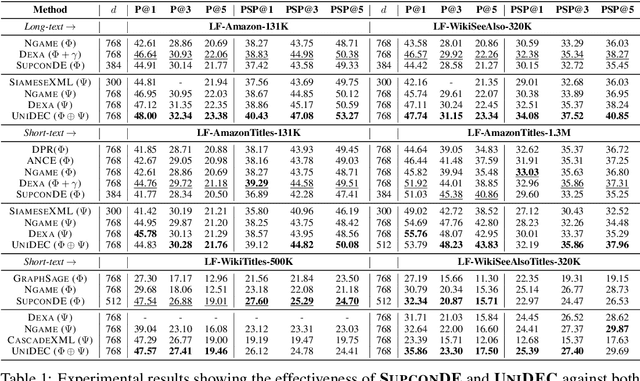

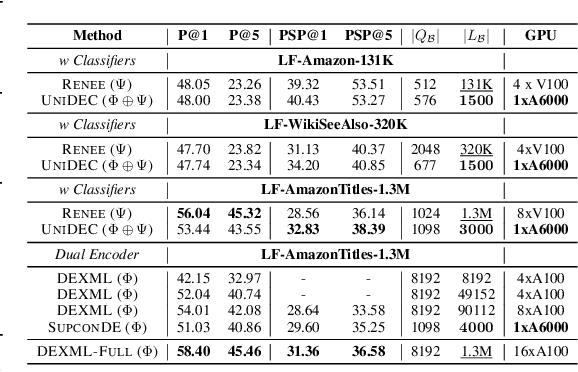
Extreme Multi-label Classification (XMC) involves predicting a subset of relevant labels from an extremely large label space, given an input query and labels with textual features. Models developed for this problem have conventionally used modular approach with (i) a Dual Encoder (DE) to embed the queries and label texts, (ii) a One-vs-All classifier to rerank the shortlisted labels mined through meta-classifier training. While such methods have shown empirical success, we observe two key uncharted aspects, (i) DE training typically uses only a single positive relation even for datasets which offer more, (ii) existing approaches fixate on using only OvA reduction of the multi-label problem. This work aims to explore these aspects by proposing UniDEC, a novel end-to-end trainable framework which trains the dual encoder and classifier in together in a unified fashion using a multi-class loss. For the choice of multi-class loss, the work proposes a novel pick-some-label (PSL) reduction of the multi-label problem with leverages multiple (in come cases, all) positives. The proposed framework achieves state-of-the-art results on a single GPU, while achieving on par results with respect to multi-GPU SOTA methods on various XML benchmark datasets, all while using 4-16x lesser compute and being practically scalable even beyond million label scale datasets.
Multi-label Learning with Random Circular Vectors
Jul 08, 2024The extreme multi-label classification~(XMC) task involves learning a classifier that can predict from a large label set the most relevant subset of labels for a data instance. While deep neural networks~(DNNs) have demonstrated remarkable success in XMC problems, the task is still challenging because it must deal with a large number of output labels, which make the DNN training computationally expensive. This paper addresses the issue by exploring the use of random circular vectors, where each vector component is represented as a complex amplitude. In our framework, we can develop an output layer and loss function of DNNs for XMC by representing the final output layer as a fully connected layer that directly predicts a low-dimensional circular vector encoding a set of labels for a data instance. We conducted experiments on synthetic datasets to verify that circular vectors have better label encoding capacity and retrieval ability than normal real-valued vectors. Then, we conducted experiments on actual XMC datasets and found that these appealing properties of circular vectors contribute to significant improvements in task performance compared with a previous model using random real-valued vectors, while reducing the size of the output layers by up to 99%.
Graphite: A Graph-based Extreme Multi-Label Short Text Classifier for Keyphrase Recommendation
Jul 29, 2024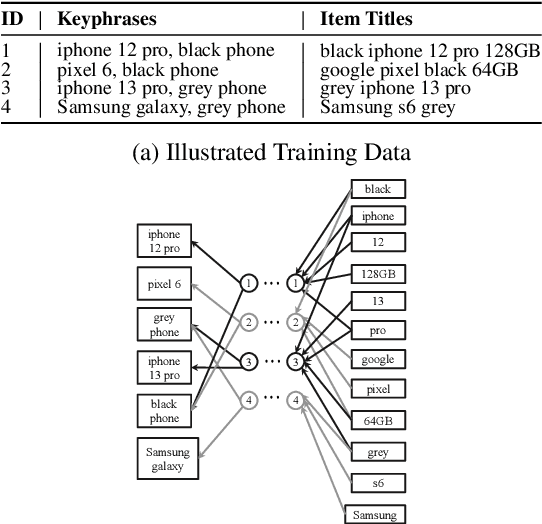
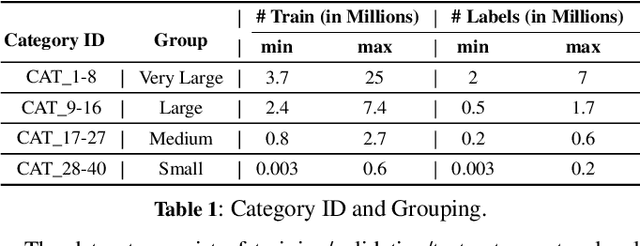
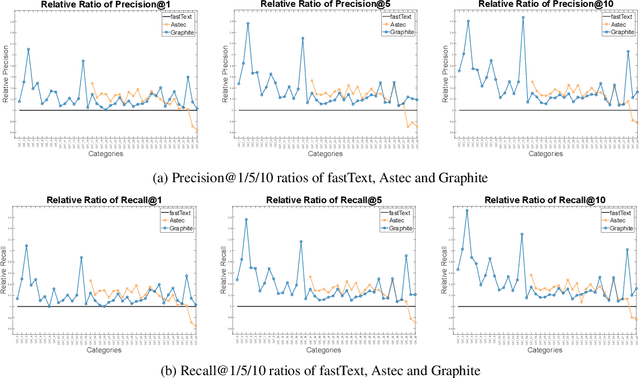

Keyphrase Recommendation has been a pivotal problem in advertising and e-commerce where advertisers/sellers are recommended keyphrases (search queries) to bid on to increase their sales. It is a challenging task due to the plethora of items shown on online platforms and various possible queries that users search while showing varying interest in the displayed items. Moreover, query/keyphrase recommendations need to be made in real-time and in a resource-constrained environment. This problem can be framed as an Extreme Multi-label (XML) Short text classification by tagging the input text with keywords as labels. Traditional neural network models are either infeasible or have slower inference latency due to large label spaces. We present Graphite, a graph-based classifier model that provides real-time keyphrase recommendations that are on par with standard text classification models. Furthermore, it doesn't utilize GPU resources, which can be limited in production environments. Due to its lightweight nature and smaller footprint, it can train on very large datasets, where state-of-the-art XML models fail due to extreme resource requirements. Graphite is deterministic, transparent, and intrinsically more interpretable than neural network-based models. We present a comprehensive analysis of our model's performance across forty categories spanning eBay's English-speaking sites.
Learning label-label correlations in Extreme Multi-label Classification via Label Features
May 03, 2024


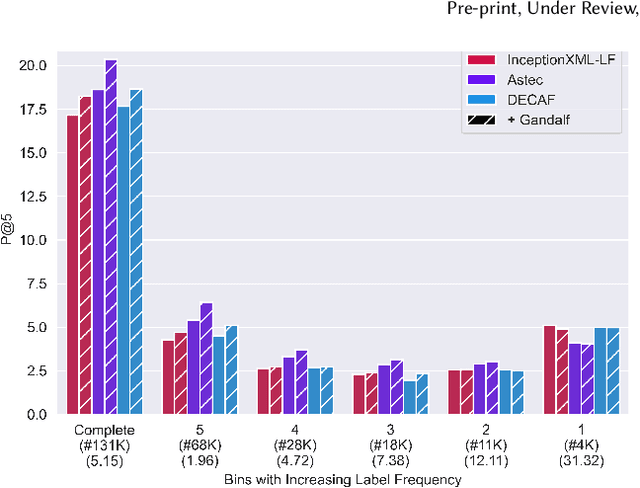
Extreme Multi-label Text Classification (XMC) involves learning a classifier that can assign an input with a subset of most relevant labels from millions of label choices. Recent works in this domain have increasingly focused on a symmetric problem setting where both input instances and label features are short-text in nature. Short-text XMC with label features has found numerous applications in areas such as query-to-ad-phrase matching in search ads, title-based product recommendation, prediction of related searches. In this paper, we propose Gandalf, a novel approach which makes use of a label co-occurrence graph to leverage label features as additional data points to supplement the training distribution. By exploiting the characteristics of the short-text XMC problem, it leverages the label features to construct valid training instances, and uses the label graph for generating the corresponding soft-label targets, hence effectively capturing the label-label correlations. Surprisingly, models trained on these new training instances, although being less than half of the original dataset, can outperform models trained on the original dataset, particularly on the PSP@k metric for tail labels. With this insight, we aim to train existing XMC algorithms on both, the original and new training instances, leading to an average 5% relative improvements for 6 state-of-the-art algorithms across 4 benchmark datasets consisting of up to 1.3M labels. Gandalf can be applied in a plug-and-play manner to various methods and thus forwards the state-of-the-art in the domain, without incurring any additional computational overheads.
FAST: A Dual-tier Few-Shot Learning Paradigm for Whole Slide Image Classification
Sep 29, 2024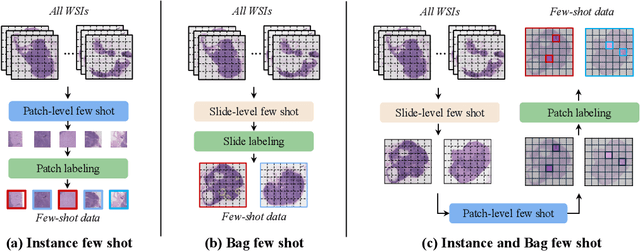
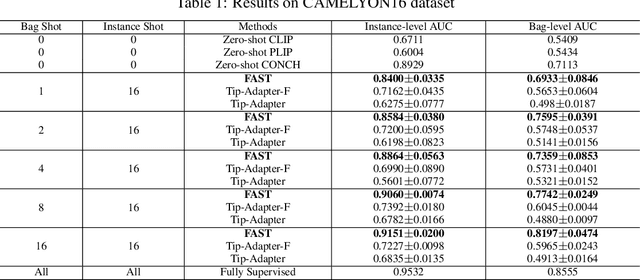
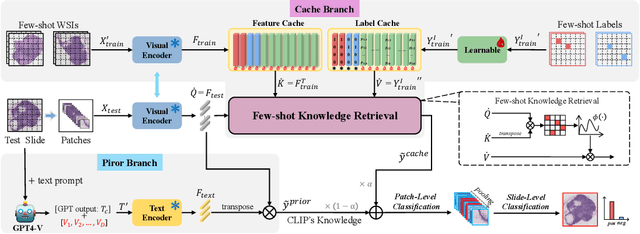
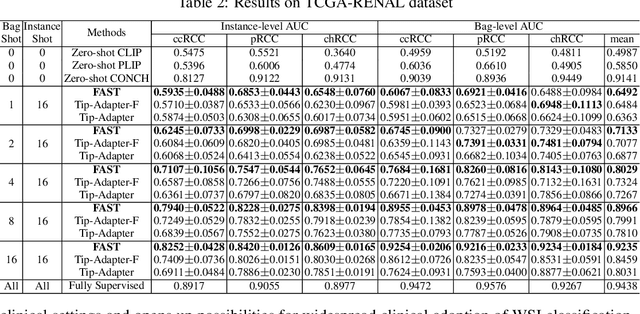
The expensive fine-grained annotation and data scarcity have become the primary obstacles for the widespread adoption of deep learning-based Whole Slide Images (WSI) classification algorithms in clinical practice. Unlike few-shot learning methods in natural images that can leverage the labels of each image, existing few-shot WSI classification methods only utilize a small number of fine-grained labels or weakly supervised slide labels for training in order to avoid expensive fine-grained annotation. They lack sufficient mining of available WSIs, severely limiting WSI classification performance. To address the above issues, we propose a novel and efficient dual-tier few-shot learning paradigm for WSI classification, named FAST. FAST consists of a dual-level annotation strategy and a dual-branch classification framework. Firstly, to avoid expensive fine-grained annotation, we collect a very small number of WSIs at the slide level, and annotate an extremely small number of patches. Then, to fully mining the available WSIs, we use all the patches and available patch labels to build a cache branch, which utilizes the labeled patches to learn the labels of unlabeled patches and through knowledge retrieval for patch classification. In addition to the cache branch, we also construct a prior branch that includes learnable prompt vectors, using the text encoder of visual-language models for patch classification. Finally, we integrate the results from both branches to achieve WSI classification. Extensive experiments on binary and multi-class datasets demonstrate that our proposed method significantly surpasses existing few-shot classification methods and approaches the accuracy of fully supervised methods with only 0.22$\%$ annotation costs. All codes and models will be publicly available on https://github.com/fukexue/FAST.
 Add to Chrome
Add to Chrome Add to Firefox
Add to Firefox Add to Edge
Add to Edge